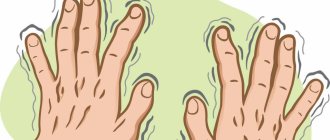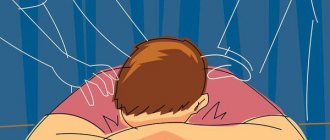In scientific circles, schizotypal personality disorder is called a borderline state between schizophrenia and normality. The disease is accompanied by unusual behavior and pathological changes in thinking. The emotional sphere undergoes a special transformation.
Comparative characteristics
First of all, a parallel is drawn between SPD and schizophrenia. The symptoms of the diseases are really similar, so with the naked eye it is difficult to distinguish one from the other. However, obvious differences are still present.
Although schizotypal disorder has many features similar to schizophrenic disorder, its course is more favorable.
Symptoms in patients with schizophrenia are more intense. Hallucinations and delusions are persistent, obsessive, and force a person to break away from reality. A persistent personality defect is formed. The intellectual sphere suffers to a greater extent, manifesting itself in illogicality and absurdity of thinking. The disease leaves a negative imprint on a person’s consciousness.
Schizoid and schizotypal personality disorders are very similar. The diseases can be called related. The distinctive criterion is still the same intensity of expression, only now the “blanket over itself” is pulled by the SPD. The disease includes illusory, mild hallucinatory manifestations, and other psychotic symptoms. In schizoid disorder, changes affect more the emotional sphere.
A common thread running through both disorders is emotional shifts: alienation and emotional coldness. Sensory disturbances stand out sharply against the background of both conditions, which makes diagnosis difficult.
But if schizoid disorder manifests itself in childhood, then the schizotypal personality appears at an older age.
A young man, 21 years old, tells his medical history: “Just recently, everything was fine with me. He had a great respect for physics and took part in Olympiads. He became interested in microbiology and entered medical school. At the same time, I played the guitar and studied foreign languages (I speak three). Suddenly everything stopped abruptly. I didn't want to do anything. I abandoned my studies and then my hobbies. Soon he dropped out of life.”
Since schizotypal disorder is accompanied by obsessive actions, it is differentiated from obsessive-compulsive disorder. Hallucinatory manifestations make it possible to compare the disease with paranoid states.
The disorder is similar to autistic diseases due to its detachment from social contacts and stereotypical behavior.
Due to its wide range of symptoms, SPD has been associated with many diseases. Experts do not recommend using the diagnosis everywhere, since its recognition is difficult.
To make a diagnosis, the International Classification of Diseases has approved criteria, of which a person must have at least 4 over the past two years:
- emotional detachment;
- pretentious behavior;
- avoidance of social contacts;
- magical thinking;
- paranoid tendencies;
- obsessive thoughts without attempts to resist on sexual, aggressive topics, dysmorphophobic thoughts;
- derealization, depersonalization;
- psychotic episodes: illusions, hallucinations, delusions without external intervention;
- detailed, stereotypical thinking, intricate speech.
Who am I?
I believe that the article will reach a new audience for me and I need to introduce myself. My name is Ivan and... I won’t go into details, I’ll try to briefly tell you about myself. Everything was fine with me before. He studied at art school and physics school, took part in various Olympiads and competitions. I took up programming, wrote in different languages, became interested in analyzing the security of computer systems, and entered the corresponding specialty. At the same time, he developed as a musician. But gradually it overwhelmed me, both my studies and my hobbies were abandoned, and I fell more and more out of my life...
Where does the disease begin?
Schizotypal disorder arose from schizophrenia, subsequently emerging as a separate illness. Bleuler, in addition to the vivid schizophrenic symptoms identified by Kraepelin, drew attention to milder forms of the disease, from which its primary names come: latent, sluggish, non-psychotic, sanatorium schizophrenia.
There is a close connection between the inheritance of schizotypal disorder from close relatives with schizophrenia. In this case, the risk of acquiring the disease increases significantly.
About 3% of our planet's population is affected by the disease. It occurs more often in men than in women.
The disease begins with banal apathy:
- prostration;
- increased drowsiness;
- fast fatiguability;
- lack of motivation to action;
- brokenness;
- lethargy.
Such a bouquet inevitably harms performance. First, the individual loses the desire for self-realization and interest in professional activities. He does everything through force - it costs him unimaginable emotional and intellectual effort. Broken by stress, a person loses his job.
The schizotypal person is deprived of aspirations, desires, and gives up his favorite activities. Becomes lack of initiative. It is really difficult for the patient to carry out any actions, even the most minimal ones. From the outside, such behavior is perceived as laziness. People around them can be angry with a person, encourage him to act, try to convict a schizotypal person of weak will, and call him a weakling. But everything is to no avail: the patient simply cannot work.
Asthenic disorders are accompanied by senesthesia and senestopathy. Senesthesia refers to non-standard sensations in the motor sphere that are difficult to interpret. The sufferer is observed to have an unnatural gait: swaying from side to side, legs tangling. Hands hang like whips, head drooping.
Senestopathies are unpleasant, indescribable sensations in the body. The patient draws them artistically:
- feet burn with fire;
- the head is boiling like in a frying pan;
- It’s hard to breathe, as if your throat is being squeezed in a vice.
When unusual sensations appear, physical pathologies are excluded.
Apathetic disorders contribute to the development of gentle behavior. In order not to waste energy, the schizotypal person gets rid of unnecessary actions. Gradually he adapts to a limited life, albeit at a lower social and professional level.
Another category of patients, on the contrary, exhibits overcompensation, finds an absorbing hobby, and plays sports to the point of exhaustion. Still others resort to drugs and alcohol. Everyone is looking for their own way of adaptation.
When pathological changes grossly change personality, a person becomes maladapted in society. In this case, he loses the ability for minimal productive functioning, even to the point of disability.
Lack of emotions
Judging by the photographs, I had emotions before. Now I don’t remember when it was. And how it was. A few years ago, things started to change. It looked something like this: first, positive emotions disappear, the ability to receive pleasure goes away, only anxiety, fear, anger remain, but then they too go away. All this happens slowly, gradually, only after the fact you begin to understand that everything has changed, that the feelings have disappeared. And it remains... But it’s not clear what remains. When a psychiatrist asks “how would you describe your mood,” the most appropriate answer is none. It's nothing. Neither good nor bad. It's simply missing. I tried for a long time to find some ways to change it, but as a result I just got tired of looking.
The only thing that changes is internal tension under stress. That's all. Sometimes the tension is so strong that it just tears you apart from the inside. For some reason doctors call it anxiety. Although perhaps this word may be suitable - vague experiences... Yes, perhaps it can be called that, but these experiences do not carry an emotional coloring. This inner tension is rather physiological in nature. The pulse and breathing quicken, the blood pressure rises, dizziness or “hammers in the head” may begin if everything is really bad, nothing more. Perhaps this is the same “splitting”, when completely opposite emotions arise simultaneously and, as a result, cancel each other out, resulting in strong tension without coloration.
The reaction to good and bad events is no different. As a result, any event passes only through the prism of logic and a positive or negative assessment is made only on the basis of practical conclusions. Delicious food is good. If it were tasteless, it would be worse. The sun is shining and the weather is generally normal - good, you can get wet in the rain. Slipped on the ice - bad, you could get injured. The car drove through a puddle and splashed my pants - it’s bad, I’ll have to wash it. No emotions.
At the same time, the instinct of self-preservation is dulled. From the point of view of a healthy person, this most likely looks like an attempt to harm oneself. But such a thought may not exist; it is rather a loss of that boundary, beyond which the likelihood of harming oneself greatly increases. Under stress, internal tension interferes with the functioning of the logical part of the brain, and there are no feelings that can provide protection at this moment.
It’s worth saying here that having lost your guide in the form of feelings, you begin to relate to many things differently. The fear of many phenomena is lost. Combined with thinking disorders, this leads to frightening reactions to external stimuli. That same incompatibility with cultural norms starts somewhere here. For example, if in a healthy person the series “Hannibal” (a show not for the faint of heart, where everyone constantly crosses the boundaries of socially acceptable behavior) evokes a whole storm of different emotions, then in my case it is complete indifference. Rather, the plot itself, the dialogues, some minor details, beautiful shots are of interest, and the characters of the series (especially Will Graham) seem closer in spirit than the people around them.
Emotional poverty
Sensual stinginess is the main symptom of schizotypal disorder. The individual simply gradually loses all emotions. The process happens unnoticed by him. One day the sufferer realizes that he feels nothing. When asked by the doctor how you characterize your mood, there is only one answer - not at all.
And the process begins with anhedonia - the inability to receive pleasure. The sick person seems to lose his taste for life. What used to please and bring pleasure now does not matter. Small and great joys are equally indifferent.
The schizotypal person isolates himself from the outside world. Withdraws into himself. Attention is introverted, leading to self-digging and self-flagellation. The patient begins to find more and more shortcomings in himself, fixating on his own worthlessness. The character takes on the traits of shyness, pronounced modesty, and touchiness. It becomes difficult to maintain normal relationships with people and actively interact with society.
Rigidity increases and the speed of response to situations decreases. Plasticity gives way to stiffness. It is difficult for a person to adapt to changing circumstances and quickly switch from one activity to another. He seems to be stuck in one situation, marking time. What was once easy to do is now difficult. Schizotypals perform even automatic actions with increased self-control.
Emotional changes significantly transform personality. Patients themselves note changes in sensory responses that differ from those socially accepted. When crossing the road, a schizotypal person will not experience fear of a car rushing towards him. The conservation instinct will remain dormant.
Gradually, affective defects become noticeable to others. People may note that the patient has become unsociable and rarely rests in company. Loses emotional connection even with close people, although he willingly falls under the care of relatives. Thus, a girl with schizotypal disorder gladly accepted help in the form of household services from her elderly mother.
The personality of the sufferer acquires psychopathic traits:
- suspiciousness;
- hysteria;
- anxiety;
- conformity - submission to someone else's opinion.
Inappropriate behavior of a person in those situations in which he previously felt quite comfortable becomes indicative.
Emotional stinginess and anhedonic attitudes deny the patient the possibility of self-acceptance, so there is no question of empathy for others. The patient reacts to other people's feelings with silence, indifference, and rational stinginess.
There are signs of schizoidization:
- coldness in relations with relatives;
- lack of interest in social life;
- introversion, fixation on one’s inner world;
- lack of empathy;
- decreased social activity;
- loss of performance;
- reduced range of needs, satisfaction of primitive needs;
- increased vulnerability;
- rigidity – emotional, intellectual.
Psychotypical personalities are divided into two types.
- Neurosis-like appearance. In the center of the image are hysterical features with asthenia and obsessions. The symptoms are similar to the manifestations of neurosis, only there is no specific psychotraumatic situation. Schizotypy appears suddenly. A frustrating experience contributes to the event.
- Psycho-like appearance. Corresponds to the manifestation of the psychopathy of the same name. The desire for loneliness, callousness, severance of social ties, and unstable mood prevail in the clinic.
Causes
What is the main causal source of the development of the disease is not known exactly.
Psychiatrists identify the following factors that contribute to the onset of painful manifestations:
- Genetic. Presence of relatives in the family with a similar problem.
- A depressing atmosphere in the house for a child, alcoholism, drug addiction among loved ones.
- Psychotrauma.
- Difficult pregnancy and pathological birth of the mother.
- Features of character and temperament.
When parents understand that they cannot do without the help of a psychiatrist, they are faced with an acute question: is it possible to cure their children. They come to our clinic for a consultation with this problem.
How does a schizotypal person think?
The thinking of schizotypal people is of particular interest. With intact intelligence and good memory, patients are forgetful. A person leaves the house, moves in a specific direction, but after a minute he completely forgets where he was going. He does not always manage to remember his destination. Periodically, the patient also cannot remember what he was doing a couple of minutes ago.
The thought process is too rational. It is predominantly schematic. Stereotyping is determined by limited concepts, dry, inflexible categories. Once created and fixed in the consciousness of the sufferer, an opinion about something cannot be changed.
Stereotypical thinking, in principle, provides invaluable help to humanity, saving time on understanding elementary, automatic actions - how to take a step, raise your hand. In schizotypal individuals, stereotyping goes beyond the norm, and no longer helps, but poisons existence.
What is associated with the mental block of a person with SPD? It's a matter of fixating the brain on unnecessary details. The intellectual organ gets stuck on secondary, insignificant things. Attention is directed in the wrong direction. Perception absorbs what is not useful for the main activity.
In some situations, this feature has its fruits. The ability to perceive small things, minor details, allows you to see more than an ordinary individual is able to absorb. Sometimes this “gift” flows into creativity.
Thinking has a philosophical orientation. The brain is attacked by mentalisms - involuntary influxes of thoughts that are particularly intrusive. They are full of crazy, sometimes perverted themes, giving rise to doubts and mistrust in the sick person.
A common type of mentalism is dysmorphophobia. An extremely valuable idea of the presence of a physical disability is born in the head. In fact, it may be absent. A complex of completeness often arises. Patients begin to be tortured by diets with illogical patterns, leading themselves to anorexia.
Dysmorphomania tends to progress, and florid obsessive thoughts and actions begin to appear. The latter flows into stereotypies. In addition, hypochondria with senestopathy is associated. A state approaches dysmorphic delirium is formed.
Sperrungs are another feature of the mental work of a schizotypal person. It manifests itself as a sudden interruption of thoughts - so-called slippages. There is a chain of thoughts in my head, and suddenly their sequence is lost. The man forgot what he was thinking about. We have to restore the events again.
Associative thinking operates on a sophisticated principle, as can be clearly seen from the association test. The patient combines objects according to a completely unthinkable principle.
Magical thinking is something worth mentioning. People with SPD tend to become fixated on superstitions and religious beliefs. One firmly believes: mention the devil and he will appear. Another is convinced that strangers are able to guide his thoughts. Thanks to the magic of thinking, the disorder was called occult schizophrenia.
There is even a special test for magical thinking - Magic Ideation Scale. MIS includes 30 questions, the answers to which are calculated by points. Then the total amount is displayed and the result is evaluated.
Schizotypal people have specific speech. Incoherent, difficult to understand. During a conversation, a person jumps from one topic to another without bringing the previous one to its logical conclusion. It is difficult to have a conversation with such people - you cannot grasp its essence.
The abrupt, illogical mental activity of a schizotypal personality causes significant trouble, exhausts, and causes rapid intellectual fatigue. Therefore, patients are not capable of long-term mental operations; they complain that they have difficulty even reading books or watching TV.
Obsessive-compulsive actions
Separately, it is necessary to note such symptoms of the disease as obsessive fears and actions. They so often accompany the illness that it is sometimes difficult to determine whether it is OCD or schizotypal disorder.
Among the frequently encountered fears are social phobia, agoraphobia, mysophobia, etc. One teenager with SR developed cancerophobia. His grandmother died of cancer. Moreover, at that moment, as he himself notes, he did not feel anything. Some time later, he watched a TV series in which they said that one of the first signs of brain cancer is phantom odors. From that moment on, he began to smell odors that were not really there. He was tormented by a terrible headache. And he was terrified that he had developed brain cancer.
An example of obsessive actions is the situation with a young guy. At school, his classmates made fun of him and bullied him in every possible way. Not knowing how to survive this, he simply repeated to himself the phrase: Lord, help. At first it was limited to 1-2 times. But then he needed to say it 10, 20 times to calm down and pull himself together.
Empathy
It is very difficult to fully empathize with another person when you do not have the emotions that he experiences. But the prism of logic can help in this situation. It is no coincidence that I gave the example of a character from the series. He and I really are similar in some ways. And the gift of “empathy” that he has is familiar to me. Where ordinary people only feel, we think and compare details that everyone usually does not notice behind emotions. And we see everything. All the falsehood, all the manipulation, all the tricks. You can actually see another person's point of view, or at least it seems like you can see it. Psychiatrists call this “magical thinking,” and say that patients think they are “reading minds.” This, of course, is not true, it’s just that attention is not drawn to where everyone usually pays it, and this is the effect that results. It is often difficult to explain your conclusions, but they are always based on some details.
The avoidance of eye contact that accompanies this process is a way to remove some of the irrelevant information and concentrate. Seeing too much and at the same time too little is a very accurate description of eye contact. A broken capillary, eye color, cat hair on a hat—the brain begins to focus on unimportant details and is distracted from the main thing. It is very difficult to face and think at the same time. And if you don’t think, then nothing will remain.
Fencing and masks
In general, I don't need communication. In any case, permanent is definitely not needed. It’s good for me to be alone, the inner world is big enough that there is no need to plug holes in it with the help of other people. Intellectual and professional communication is generally perceived as normal; it does not affect emotions. But with everyday things it’s more complicated and it’s not always possible to avoid it.
In order not to stand out from the environment, you have to put on masks of emotions that were formed not by internal processes, but by long-term observation of others. They don't always turn out appropriate or natural, and I think it's noticeable. Everyone smiles in some situation - you should smile too, everyone is sad - you should be sad too. This is what it looks like. But it gets tiring very quickly and you need to rest a lot. It's like being an actor - hard work. You have to put on the image of another person who is alien to you. That's not you. Perhaps it is this behavior that leads to the myth that schizophrenia is a split personality. But that's not true. This is one person under the mask and without it.
Showing emotions
Since there is nothing special to show, from the outside people like me may seem cold and detached. Facial expressions are poor, the voice is also little modulated, almost always monotonous and uniform. In combination with a certain appearance and clothing, the image of a monk can be formed.
Sometimes there are smiles, or it’s better to even call it antics. Involuntary reactions that have nothing to do with emotions. They can cause a feeling of fear and abnormality in those around them, since they often do not correspond to the surrounding environment. It's like horror stories with clowns - it breaks your brain and causes mixed feelings. Not all people know that these antics are not a manifestation of good nature or a good mood, and this sometimes, in the process of talking with someone, leads to the thought “no one is bothering me.” Indeed, the appearance of others is not always interpreted correctly and it is completely unclear what can be done about it. No matter how strange it may sound, dogs understand me better than people.
What else am I doing with my condition?
I had to look for some activities that would distract me from bad thoughts and gradually return me from complete powerlessness and inaction to a more or less working state. In this regard, cooking turned out to be a good activity. Not a very long action at a time - you can force yourself, and it’s an activity you can focus on. It is important. You need to carefully cut everything, keep track of time, collect a bunch of different ingredients, then serve – that’s also another task. And at the end - a bonus in the form of a beautiful tasty treat. It won't bring you joy, but it's better than store-bought pasta. If you cook something new every day, you can discipline yourself a little and motivate yourself. This really helps with apathy.
Over time, development was added to cooking. It was difficult to return to information security after being thoroughly knocked out of this topic. And it’s problematic to get permission to go to different places while registering. I began to master a new area for myself - layout, development of non-standard sites. Of course, there was no talk of any study for 8-10 hours a day. I started with sessions for half an hour, then an hour a day. That's how I studied it. Part-time jobs have appeared. Over the course of a couple of years, I got very deep and began to do things that surprise many. Before I started describing all this in articles, people simply didn’t believe me that I made my portfolio myself.
During the treatment, slight tremors in the hands also appeared due to antipsychotics. It helps to play musical instruments - guitar and piano. I don't quite understand how it works, but the effect is noticeable. If you don't play for a couple of days, the tremor gets worse. I also added an hour a day of music classes. In small steps I wrote a book - a manual on flamenco guitar. I started writing sketches. First small, then longer. If anyone is suddenly interested, you can listen to the synthesized recordings. It’s not yet possible to record everything live myself. But he published the collections in printed form.
All I mean is that even with serious problems, you can achieve something. By studying for an hour a day, you can slowly but surely achieve something. I am surprised when completely healthy people say that they cannot achieve anything. You can do everything.
Misunderstanding
Very often I draw conclusions based on my observations, on many small details, and the people around me (even some doctors) consider my conclusions to be manifestations of anxiety and paranoia. At the same time, they themselves are busy with emotions and, in my opinion, are blind. Sometimes you even have to look for documentary evidence of your statements in order to prove something to them. And they are often found. So, people: just because you think someone is paranoid doesn’t mean they aren’t being watched. And given the long period of experience in information security, I know about many things not only “what” can be done, but also approximately “how” it can be done. So there is a very thin line of insanity here, you shouldn’t push everyone under it.
People often misunderstand me. Due to my lack of emotion, I often appear simply calm. And everyone around me can suddenly decide that I’m sad and start doing something to cheer me up. But I’m not sad, they came up with it all themselves. And communication with psychologists is absolutely beautiful. They immediately begin to manipulate and I see all this and... I think the best way to describe this state is this: imagine that you know how to perform some kind of trick with cards. You know how it works. And then you sit and watch someone else show it. And as if you should be surprised, but you can’t - you know how everything works and you can’t force yourself to unsee it all. And as a result, the psychologist thinks something one thing, you think something else, and the result is a residue in the form of “the psychologist came up with something for himself.” This happened to me more than once and I stopped classes after the first visit. Not because I was “running away from my problems,” as the psychologist saw it, but because I “almost fell asleep at this boring show.”









